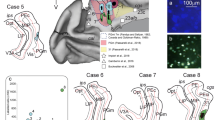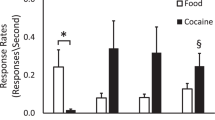Abstract
The nucleus accumbens (NA), which receives inputs from limbic structures and projects to the motor system, may be important for the association of reinforcement with action. There are projections to the NA from the amygdala and hippocampus. Discrimination and reversal learning tasks which are known to be disrupted by lesions to these areas in monkeys were given to monkeys with lesions of the NA. Twelve monkeys (Macaca fascicularis) were used in the present study. Six of these received ibotenic acid lesions which resulted in considerable cell loss in the NA; the remaining six acted as controls. The first group of six monkeys were taught a visual discrimination task pre-operatively. Post-operatively, these monkeys were tested on visual and spatial discrimination and reversal tasks. A second group of six monkeys were tested on a motor reversal task. The results indicate that ibotenic acid lesions of the NA transiently impair spatial but not visual reversal learning in monkeys. The NA lesions did not impair a monkey's ability to perform visual or spatial discriminations, or the ability to perform the motor learning or motor reversal tasks. Our results suggest that bilateral lesions of the NA in monkeys do not disrupt the ability to discriminate basic properties of reward-related stimuli or the formation of visual stimulus-reward associations. In addition, our results argue against theories which suggest that the NA is important for behavioural switching or general behavioural flexibility. We conclude that the NA may play a more specific role in the association of temporal and spatial cues with movement and reward.
Similar content being viewed by others
References
Aggleton JP, Friedman DP, Mishkin M (1987) A comparison between the connections of the amygdala and hippocampus with the basal forebrain in the macaque. Exp Brain Res 67: 556–568
Apicella P, Ljungberg T, Scarnati E, Schultz W (1991) Responses to reward in monkey dorsal and ventral striatum. Exp Brain Res 85: 491–500
Baleydier C, Mauguiere F (1980) The duality of the cingulate gyrus in monkey. Neuroanatomical study and functional hypothesis. Brain 103: 525–554
Cador M, Robbins TW, Everitt BJ (1989) Involvement of the amygdala in stimulus-reward associations: interaction with the ventral striatum. Neuroscience 30: 77–86
Carr GD, White N (1983) Conditioned place preference from intra-accumbens amphetamine but not intra-caudate amphetamine injection. Life Sci 33: 2551–2557
Chen Y-C, Thaler D, Nixon PD, Stern CE, Passingham RE (1995) The functions of the medial premotor cortex. II. The timing and selection of learned movements. Exp Brain Res 102: 461–473
Everitt BJ, Cador M, Robbins TW (1989) Interactions between the amygdala and ventral striatum in stimulus-reward associations: studies using a second-order schedule of sexual reinforcement. Neuroscience 30: 63–75
Everitt BJ, Morris KA, O'Brien A, Robbins TW (1991) The basolateral amygdala ventral striatum system and conditioned place preference — further evidence of limbic striatal interactions. Neuroscience 42: 1–18
Gaffan D (1985) Hippocampus: memory, habit and voluntary movement. Philos Trans R Soc Lond 308: 87–100
Gaffan D (1992) Amygdala and the memory of reward. In: Aggleton JP (ed) The amygdala: neurobiological aspects of emotion, memory and mental dysfunction. Wiley, New York, pp 471–483
Gaffan D, Harrison S (1987) Amygdalectomy and disconnection in visual learning for auditory secondary reinforcement by monkeys. J Neurosci 7: 2285–2292
Gaffan D, Harrison S (1989) Place memory and scene memory: effects of fornix transection in the monkey. Exp Brain Res 74: 202–212
Gaffan D, Gaffan EA, Harrison S (1988) Disconnection of the amygdala from visual association cortex impairs visual reward-association learning in monkeys. J Neurosci 8: 3144–3150
Gaffan D, Gaffan EA, Harrison S (1989) Visual-visual associative learning and reward-associated learning: the role of the amygdala. J Neurosci 9: 558–564
Gaffan D, Murray EA, Fabre-Thorpe M (1993) Interaction of the amygdala with the frontal lobe in reward memory. Eur J Neurosci 5: 968–975
Haber SN, Lynd E, Klein C, Groenewegen HJ (1990) Topographic organization of the ventral striatal efferent projections in the rhesus monkey: an anterograde tracing study. J Comp Neurol 293: 282–298
Hagan JJ, Alpert JE, Morris RGM, Iversen SD (1983) The effects of central catecholamine depletion on spatial learning in rats. Behav Brain Res 9: 83–104
Heimer E, Wilson RD (1975) The subcortical projections of the allocortex: similarities on the neural associations of the hippocampus, the piriform cortex, and the neocortex. In: Santini M (ed) Golgi centennial symposium. Raven, New York, pp 177–193
Hemphill M, Holm G, Crutcher M, DeLong MR, Hedreen J (1981) Afferent connections of the NA in the monkey. In: Chronister R, DeFrance J (eds) Neurobiology of the nucleus accumbens. Haer Institute Press, Brunswick, Me, pp 71–81
Jones B, Mishkin M (1972) Limbic lesions and the problem of stimulus-reinforcement associations. Exp Neurol 36: 362–377
Koob GF, Riley SJ, Smith SC, Robbins TW (1978) Effects of 6-hydroxydopamine lesions of the nucleus accumbens septi and olfactory tubercle on feeding, locomotor activity, and amphetamine anorexia in the rat. J Comp Physiol Psychol 92: 917–927
Lyness WH, Friedle NM, Moore KE (1979) Destruction of dopaminergic nerve terminals in nucleus accumbens: effect on gemdamphetamine self-administration. Pharmacol Biochem Behav 11: 553–556
Mesulam M-M, Mufson EJ, Wainer BH, Levey AI (1983) Central cholinergic pathways in the rat: an overview based on an alternative nomenclature (Ch1-Ch6). Neuroscience 10: 1185–1201
Mogenson GJ, Jones DL, Yim CY (1980) From motivation to action: functional interface between the limbic system and the motor system. Prog Neurobiol 14: 69–97
Passingham RE (1988) Premotor cortex and preparation for movement. Exp Brain Res 70: 590–596
Phillips AG, Fibiger HC (1990) Role of reward and enhancement of conditioned reward in persistence of responding for cocaine. Behav Pharmacol 1: 269–282
Robbins TW, Cador M, Taylor JR, Everitt BJ (1989) Limbic-striatal interactions in reward-related processes. Neurosci Biobehav Rev 13: 155–162
Rolls ET, Williams GV (1987) Neuronal activity in the ventral striatum of the primate. In: Carpenter MB, Jayamaran A (eds) The basal ganglia, vol II, Structure and function. (Current concepts) Plenum, New York, pp 349–356
Russchen FT, Amaral DG, Price JE (1987) The afferent input to the magnacellular division of the mediodorsal thalamic nucleus in he monkey, Macaca fascicularis. J Comp Neurol 253(4): 1–36
Russchen FT, Bakst I, Amaral DG, Price JE (1985) The amygdolostriatal projections in the monkey. An anterograde tracing study. Brain Res 329: 241–257
Schultz W, Apicella P, Scarnati E, Ljungberg T (1992) Neuronal activity in monkey ventral striatum related to the expectation of reward. J Neurosci 12(12): 4595–4610
Spyraki C, Fibiger HC, Phillips AG (1982) Dopaminergic substrates of amphetamine-induced place preference conditioning. Brain Res 253: 185–193
Spyraki C, Fibiger HC, Phillips AG (1983) Attenuation of heroin reward in rats by disruption of the mesolimbic dopamine system. Psychopharmacology 79: 278–283
Stern CE, Passingham RE (1994) The nucleus accumbens in monkeys (Macaca fascicularis). I. The organization of behaviour. Behav Brain Res 61: 9–21
Stern CE, Passingham RE (1995) The nucleus accumbens in monkeys (Macaca fascicularis). II. Emotion and motivation. Behav Brain Res (in press)
Sutherland RJ, Rodriguez AJ (1989) The role of the fornix/fimbria and some related subcortical structures in place learning and memory. Behav Brain Res 32: 265–277
Taghzouti K, Louilot A, Herman JP, Le Moal M, Simon H (1985) Alternation behavior, spatial discrimination, and reversal disturbances following 6-hydroxydopamine lesions in the nucleus accumbens of the rat. Behav Neural Biol 44: 354–363
Thaler DE, Chen Y-C, Nixon PD, Stern CE, Passingham RE (1995) The functions of the medial premotor cortex. I. Simple learned movements. Exp Brain Res 102: 445–460
Williams GV, Rolls ET, Leonard CM, Stern CE (1993) Neuronal responses in the ventral striatum of the behaving macaque. Behav Brain Res 55: 243–252
Author information
Authors and Affiliations
Rights and permissions
About this article
Cite this article
Stern, C.E., Passingham, R.E. The nucleus accumbens in monkeys (Macaca fascicularis). Exp Brain Res 106, 239–247 (1995). https://doi.org/10.1007/BF00241119
Received:
Accepted:
Issue Date:
DOI: https://doi.org/10.1007/BF00241119




